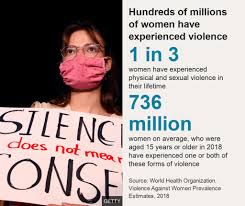Today is another rant caused by falling down that "rabbit hole" again. I really should probably not use the internet like I do because I am constantly exposed to curious or irritating things that make me pause and search for more information. Once that starts, I end up finding out all kinds of things best left alone and that usually causes me to rant and rave to myself and you if I feel like blogging.
So, today's issue is about violence toward women. This issue dates back to ancient times and it seems that not much has changed since then despite all the women's movements and all the legislation about stopping it. Here is where my rant comes in: if there is documentation that supports the fact that 1 in 3 women alive today will experience some form of violence. These are mothers, sisters, aunts, daughters and other family members that have people who care about them; but that does not prevent them from becoming victims.
What is the problem with fixing this issue? Why can we not find a solution? Why instead is it acceptable that we have to establish national databases to list the missing and deceased women? Shouldn't that make you wonder why we have to do such a thing?
A Brief History of the Violence Against Women:
Violence against women has been a persistent issue throughout human history, and it takes many forms, including physical, sexual, psychological, and economic violence. Despite various efforts to tackle this problem, it remains prevalent in almost all societies and affects women of all ages, races, ethnicities, and socio-economic backgrounds.
The earliest records of violence against women can be traced back to ancient civilizations. For example, in ancient Greece and Rome, women were treated as inferior beings, and violence against them was often considered a normal part of life. Women were frequently subjected to sexual violence, including rape, and there was little legal recourse for them to seek justice. Similarly, in many traditional societies, women have been seen as property and treated as such. Practices such as female genital mutilation, honor killings, and forced marriages continue to be prevalent in some parts of the world.
During the 19th and early 20th centuries, women's rights movements emerged in many countries, and they began to advocate for women's equality and an end to violence against women. These movements were instrumental in bringing about legal changes, such as the right to vote and the right to own property. However, violence against women continued to be a problem, and many women were still unable to access justice or support.
In recent decades, there have been many global initiatives to address violence against women. The United Nations has played a key role in this, with the adoption of the Convention on the Elimination of All Forms of Discrimination against Women (CEDAW) in 1979 and the Declaration on the Elimination of Violence against Women in 1993. These instruments have helped to establish legal frameworks and standards for addressing violence against women, and they have been used as a basis for national legislation and policy development.
Despite these efforts, violence against women remains a significant problem in many parts of the world. According to the World Health Organization, 1 in 3 women worldwide experience physical or sexual violence in their lifetime. In some regions, such as sub-Saharan Africa, the prevalence is even higher. Additionally, violence against women is often underreported and goes unpunished, and many women still face significant barriers to accessing justice and support.
The history of violence against women is a long and complex one, with deep-rooted cultural and societal attitudes that have perpetuated this problem. While progress has been made in recent decades, much work remains to be done to eradicate this form of violence and ensure that women everywhere are able to live free from fear and abuse.
Economic costs of violence against women and girls:
According to the article, "Facts and figures: Ending violence against women",
"Violence against women can result in significant costs to the state, to victims/survivors, and communities. Costs are both direct and indirect, and tangible and intangible. For example, the costs of the salaries of individuals working at shelters are direct tangible costs. Costs are borne by everyone, including individual victims/survivors, perpetrators, the government and society in general.
What are the Causes:
- men can’t control their anger or sexual urges;
- alcohol causes men to be violent;
- women could leave violent partners if they wanted to; and
- men experience equal, if not greater, levels of violence perpetrated by their partners or former partners.
- the unequal distribution of power and resources between men and women;
- an adherence to rigidly defined gender roles and identities i.e., what it means to be masculine and feminine.
- justify violence against women, based on the notion that it is legitimate for a man to use violence against a woman;
- excuse violence by attributing it to external factors (such as stress) or proposing that men cannot be held fully responsible for violent behavior (for example, because of anger or sexual urges);
- trivialize the impact of violence, based on the view that the impacts of violence are not serious or are not sufficiently serious to warrant action by women themselves, the community or public agencies;
- minimize violence by denying its seriousness, denying that it occurs or denying that certain behaviors are indeed violence at all; h
- hold women at least partially responsible for their victimization or for preventing victimization.











